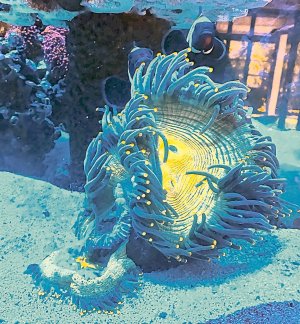Elegance can be very touchy. Used to just get to a certain point and die like some goniopora.
Australian Elegance seem to be better.
Can you get a white picture without blue..
My first thought was budding too. It does happen.
Yea if it was on the sand moving it up may have been the problem, not only that corals once established do not like to be moved. Elegance prefer the sand because there skeletons are sharp and the weight of the flesh can damage them plus it is where they come from mostly in the wild. Allot of the lps with cone type skeletons do.
I have had lps detach from the skeleton too, polyp bale out. A lot of corals can do it but elegance is one polyp so you do not want it.. Not sure the cause then.
I would get a icp test make sure nothing is happening with the water like heavy metals just to rule that out.
How high are the nitrates? You may want to get them in check depending on how high.
Thank youI would look at any changes that have happened over the last several months. Depending on the energy reserves a coral has and the stress event(s), when stressed it can take weeks to months for a to show. I would try to think back to when it first started to shrink and list anything that happened then.

